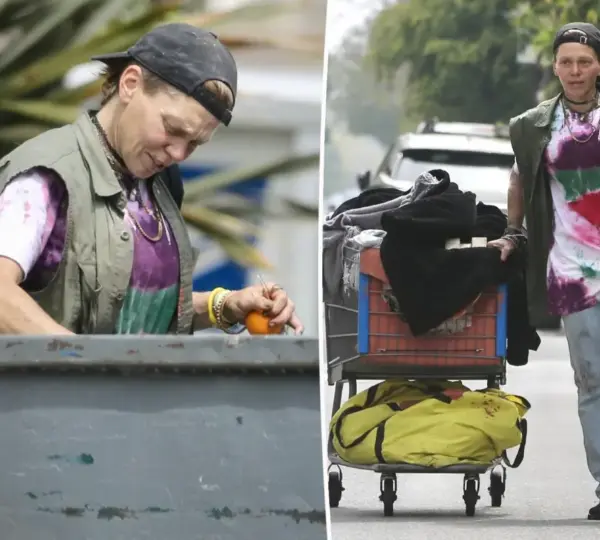For years, the name Loni Willison was associated with flawless beauty, radiant confidence, and the kind of fitness-model physique that turned heads in every room she entered.
She graced magazine covers, built a strong presence in the modeling world, and lived a life many young women believed to be glamorous and enviable.
Her striking features, golden hair, and dedicated physical regimen helped her carve a name for herself in an industry driven by appearance and public fascination.
But today, that same woman — once photographed under bright professional studio lights — is more often seen under the harsh glare of streetlamps, pushing a shopping cart full of discarded belongings, wandering barefoot, or digging through dumpsters in California’s busiest neighborhoods.
Her downward spiral has become one of the most heartbreaking transformations witnessed by fans and media alike.
And now, after years of silence and speculation, Loni has spoken again — not only about her drug addiction and homelessness, but about who she believes set her downfall in motion.
When an interviewer recently asked her what moment caused her life to unravel, Loni didn’t pause, hesitate, or soften her words. She spoke with the clarity of someone who has carried a painful truth for a long time.
“My ex-husband,” she said. “Getting married. At least I got divorced. He set everything up to do this to me.”
Her voice wasn’t bitter — it was heavy, resigned, as though the weight of her past had been sitting on her shoulders for years, and she had finally found the strength to speak it out loud.
A Marriage That Ended in Chaos
Loni and Jeremy Jackson — the “Baywatch” actor once known as Hollywood’s handsome golden boy — married in 2012. But behind the scenes, their marriage was turbulent, volatile, and marked by accusations of drug abuse, emotional breakdowns, and violence.
Their marriage collapsed in 2014 after a disturbing incident that made headlines. Jackson allegedly tried to choke her during a drunken, violent fight. The event left Loni traumatized and marked what she calls the beginning of her long emotional and psychological decline.
After the split, the tight and structured world of modeling began to slip away from her. Without the stability of her marriage, her career, or her mental health, the cracks that had been forming for years finally broke open.
It wasn’t long before she disappeared from public view entirely.
Vanishing From the Spotlight
For nearly four years, Loni vanished. No public appearances. No modeling shoots. No updates. No sightings.
Then, in 2018, she resurfaced — but not as the glamorous fitness icon the public remembered.
She was photographed wandering the streets of Los Angeles:
Her hair cut short and uneven
Her face strained and exhausted
Several front teeth missing
Her body visibly thin and frail
Her clothes torn, dirty, and oversized
The contrast was shocking. This was not a fall from fame. This was a complete collapse.
And now, years later, she is still struggling to survive on the streets.
A Life Filled With Pain: “I’m in a lot of pain.”
During her latest interview, Loni opened up about her physical suffering. She admitted:
Her stomach hurts “really bad”
She feels intense chronic pain
Her hands and fingers are severely injured
She cannot bring herself to go to a doctor
When the interviewer gently suggested she should get medical help for her damaged fingers, she simply responded:
“I’ll be fine.”
But the words didn’t sound confident. They sounded tired.

Her Biggest Fear: Electricity
One of the most troubling aspects of Loni’s current situation is her belief that she cannot be in any building because she is “electrosensitive.”
According to her, she was “electrocuted every day for almost a year,” and now her body reacts to electricity in ways that make indoor living impossible.
She explained:
“I can’t live inside anywhere. I pick up on electricity, I pick up on chemicals, batteries, fuses, wire, metal. I think my body filters that stuff.”
Her statements reveal mental-health struggles far deeper than addiction alone. Her fears appear deeply rooted and emotionally charged — a sign that she may be battling paranoia, trauma-related psychosis, or delusional thought patterns, conditions tragically common among people who spend long periods without stable housing or medical care.
She added:
“I’d need a big X-ray or sonogram machine to figure it out.”
There is no anger or resentment in her voice. Only fear and exhaustion.
“Nothing anyone can offer me.”
Throughout the interview, Loni made it clear that she refuses help — not because she doesn’t want support, but because she doesn’t believe healing is possible.
“There’s nothing anybody can offer me. Nothing can help.”
She says she has never asked the city for help, even though people have offered rehabilitation programs, housing assistance, and medical support.
When asked whether she was satisfied with how her life turned out, Loni shrugged lightly.
“I’m not necessarily happy… but whatever.”
It was the kind of answer that reveals a person who has lived in survival mode for so long that she no longer dares to imagine something better.
Her Earlier Confession: “I was addicted to crystal meth.”
In 2018, she admitted she was addicted to crystal meth and believed she was being “tortured” in her home — another sign of the intense mental and emotional turmoil that engulfed her.
Her Ex-Husband’s Dark Past
Jeremy Jackson, now 42, has faced his own demons:
Drug and steroid addiction
Alcohol abuse
Violent outbursts
Legal troubles
In 2015, he allegedly stabbed a woman in Los Angeles. Two years later, he accepted a plea deal and served jail time.
His own admissions over the years paint a picture of a man also spiraling through addiction and instability — but it is Loni who suffered the most severe consequences.
Where he found help, she fell into homelessness.
Where he regained stability, she lost everything.
A Shocking Contrast: From Glamour to Survival
Loni once earned money from:
Modeling magazines
Fitness photoshoots
Advertising campaigns
Acting and promotional appearances
Now, she collects recyclables, searches for food in dumpsters, and sleeps outdoors because she believes she cannot live inside any home due to electricity.
Her story is one of the most extreme downward spirals that Hollywood has witnessed — not sensationalized, but painfully real.
And yet, even in her most vulnerable public moments, she remains polite, soft-spoken, and gentle. Fans who encounter her say she is kind and thankful, even when she has nothing.
For as long as most people can remember, Loni Willison’s story has been told through harsh headlines, intrusive photographs, and public speculation. But behind every shocking picture, there is a human being — someone with a history, a heart, a past, and a life that did not unravel overnight. Part 2 digs into the deeper layers of her journey, the complexities of addiction, the emotional trauma she carries, and the faint but still-present possibilities for hope.
Because Loni Willison’s story is not only about loss — it is also about survival in the face of unimaginable loneliness.
Her Reality Today: A Daily Battle Between Pain and Isolation
To understand Loni in 2024, you must imagine a life where every day begins with the same question:
Where can I be that feels safe enough, quiet enough, and far enough from everything that hurts me?





